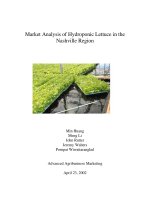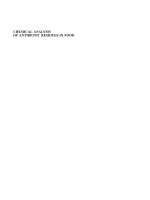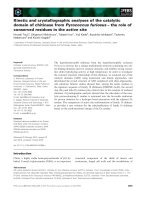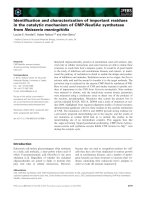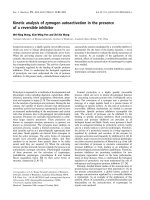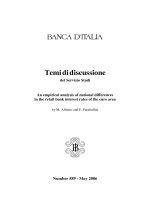Analysis of quinolones residues in milk using high performance liquid chromatography
Bạn đang xem bản rút gọn của tài liệu. Xem và tải ngay bản đầy đủ của tài liệu tại đây (311.45 KB, 10 trang )
Int.J.Curr.Microbiol.App.Sci (2019) 8(2): 3049-3058
International Journal of Current Microbiology and Applied Sciences
ISSN: 2319-7706 Volume 8 Number 02 (2019)
Journal homepage:
Original Research Article
/>
Analysis of Quinolones Residues in Milk using High Performance
Liquid Chromatography
Priyanka, Vijay J. Jadhav*, Sneh Lata Chauhan and S.R. Garg
Department of Veterinary Public Health & Epidemiology, College of Veterinary Sciences,
Lala Lajpat Rai University of Veterinary and Animal Sciences, Hisar, Haryana- 125004, India
*Corresponding author
ABSTRACT
Keywords
HPLC, Quinolones,
Milk, Antimicrobial
residues, MRL
Article Info
Accepted:
22 January 2019
Available Online:
10 February 2019
In the present study, High Performance Liquid Chromatography with Ultra-Voilet detector
(HPLC-UV) technique was standardized and validated for the detection and quantitation of
quinolones antimicrobial residues viz. enrofloxacin, norfloxacin and ciprofloxacin from
milk. The standardization procedure showed that the values for the system precision (%
RSD) for both the analytes was 11% for area and <0.9% for retention time), linearity
(r2>0.98), specificity and accuracy (70-110%) and precision (<10%) were within accepted
range and demonstrated system suitability for analysis of milk samples. The standardized
and validated method was applied for the detection of quinolones residues from 100
randomly milk samples collected from local market of Hisar (Haryana). Mean
concentrations of norfloxacin and enrofloxacin antimicrobial residues in market milk
samples were 3.54 and 2.02 µg/kg, respectively. A total of 8 samples were found to be
containing quinolone antimicrobial residues. Comparison of antimicrobial concentration in
each positive sample of milk with international MRLs showed that, none of the three
antimicrobial was responsible for violations of set residue limits. It was concluded that
milk is significant source of antimicrobial residues.
Introduction
Since the early 1960s, there has been two-fold
increase in per capita milk consumption of
developing countries. This increased demand
of milk made it essential to adopt extensive
animal husbandry practices. Use of veterinary
drugs for taking cure of variety of ailments in
farm animals is an integral component of such
extensive animal husbandry practices.
Antibiotics are the most widely used
veterinary drugs for therapeutic and
prophylactic purposes and also as growth
promoter in dairy animals which may appear
in milk as residues for a certain time period
(Wassenaar, 2005). They are also be used at
sub-therapeutic levels to increase feed
efficiency, promote growth and prevent
diseases (Ronquillo and Harnandez, 2016).
According to one estimate, approximately
80% of the food-producing animals receive
medication for part or most of their lives
(Pavlov et al., 2008). The use of antibiotics
therapy to treat and prevent udder infections
in cows is a key component of mastitis
control in many countries. The extra-label use
3049
Int.J.Curr.Microbiol.App.Sci (2019) 8(2): 3049-3058
treatment of human infections, insufficient
withdrawal period and lack of records are the
most common causes of these residues in
milk. In addition the lack of good veterinary
practice and illegal use of veterinary drugs by
farmers will increase this problem (MacEven
et al., 1991).
Nowadays, beta-lactams (penicillin G,
ampicillin, amoxicillin etc), aminoglycosides
(streptomycin, neomycin etc) and tetracycline
(tetracycline, oxytetracycline etc) antibiotics
are the most frequently used antimicrobials
for treatment of mastitis in dairy cows and
consequently, the most commonly found
residues in milk (Gustavsson et al., 2004).
Also several quinolones such as danofloxacin,
difloxacin, enrofloxacin are specifically used
in veterinary medicine (Reeves, 2012).
Although use of antimicrobials is essential, its
frequent use may result in occurrence of drug
residues in food products viz. meat and milk
obtained from exposed animals.
Fluoroquinolones are synthetic class broad
spectrum antibacterials primarily active
against Gram negative pathogens. These are
effective for the therapy of serious infections,
e.g. septicemia, gastroenteritis and respiratory
diseases and also used for the treatment of
infections of the urinary tract and soft tissues
(Nizamlıoglu and Aydın, 2012). They are
effective in the therapy of mycoplasma
infections and infections caused by atypical
bacteria (Navratilova et al., 2011). In
veterinary medicine, they are useful
especially in the therapy for gastrointestinal
and respiratory tract infections, enrofloxacin
being the most widely used fluoroquinolone
in veterinary medicine (Monica et al., 2011).
Fluoroquinolone preparations are also used
for the prevention and treatment of mastitis in
lactating cows and for dry cow therapy (Gruet
et al., 2001).
Antimicrobials causes broad range of health
effects, to summarize they can cause
development anomalies e.g. bone marrow
aplasia and can alter the normal
gastrointestinal microflora resulting in GI
disturbances and development of resistant
strains of bacteria. Therefore, the use of
antimicrobials may result in emergence of
antibiotic resistant strains of pathogens,
complicating the treatment for both human
and animal diseases (Dewdney et al., 1991;
Goffova et al., 2012). In addition some of the
antibacterial may act as carcinogens and procarcinogens.
Widespread use of antimicrobials has created
potential residue problems in milk and milk
products making it an important public health
hazard. In India especially Haryana, there is a
paucity of reports related to occurrence of
antimicrobial residues in milk. Therefore, the
present investigation was planned with the
objective to standardize the high performance
liquid chromatography (HPLC) technique for
detection and quantification of quinolones
antimicrobial residues.
Materials and Methods
Collection of samples
The present work was carried out in the
Department of Veterinary Public Health and
Epidemiology, LUVAS, Hisar. For this, 100
milk samples were randomly collected from
local market of Hisar, among which, 80
samples of raw milk and 20 samples of
pasteurized milk of various brands were
included. Samples were collected in sterile
plastic bottles and stored at -20C till
analysis.
Chemicals and Reagents
The analytical standards of antimicrobials viz.
norfloxacin,
ciprofloxacin,
enrofloxacin
having purity more than 98% were procured
from Sigma-Aldrich. Supelclean™ LC-18 SPE
3050
Int.J.Curr.Microbiol.App.Sci (2019) 8(2): 3049-3058
Tube having bed wt. 500 mg and volume
3 mL were also procured from SigmaAldrich. HPLC grade solvents namely
methanol and acetonitrile were procured from
Fisher Scientific whereas anhydrous sodium
sulphate was procured from Qualigens. HPLC
grade water was prepared in the laboratory
using Millipore (Bedford, MA, USA) Milli-Q
system to give a resistivity of at least 18.2 M
Ω cm.
Preparation of standards
The primary standard solution of each
antimicrobial was prepared by dissolving neat
standards of quinolones in methanol by using
class A glassware (Final volume 25 ml) so
that effective concentration remained more
than 100 μg/mL. Secondary standard
solutions, the maximum residue limits
(MRLs) prescribed by European Union (EU,
2010) for all antibiotics were considered.
Based on these MRL values, a linearity range
was selected (50, 100, 150, 200, 250 ng/ml)
for quinolones, Then appropriate dilutions of
secondary standard solution in same solvent
were made to produce a required dilution of
working solution. Mobile phase used for the
instrumental analysis of quinolones was
composed of solvent A (water: formic acid at
1000:1 v/v) and solvent B (water: acetonitrile:
formic acid (at 100:900:1 v/v/v). In the
present study, HPLC-UV method was
standardized
and
validated
for
the
determination of quinolones i.e. enrofloxacin,
norfloxacin and ciprofloxacin based on the
method reported by Stolker et al., (2008) with
slight modifications.
mixed with 25-30 g sodium sulphate until
slurry was formed. Twenty millilitre
acetonitrile was added to it and centrifuged at
7000 rpm for 15 minutes. 15 mL of the
supernatant was taken out in a beaker and 10
mL of acetonitrile was again added to the
centrifuge tube and re-centrifuged (7000
rpm/15 minutes). Supernatant was collected
in a 50 mL beaker. This procedure was
repeated again and supernatant was added to
previously collected extract in measuring
cylinder.
For sample cleanup, solid phase C18 cartridge
was attached to vacuum manifold and
activated with 6 ml methanol followed by 6
ml water using vacuum manifold. Sample
extract was loaded on the activated cartridge.
Then cartridge was eluted using 15 mL
methanol. The cleaned up extract as well as
eluent was collected in pear shaped
evaporating flask and evaporated to dryness at
55ºC using a rotary evaporator. Residue in
flask were redissolved in 2 mL methanol and
subjected for chromatographic analysis for
quinolones.
Chromatographic analysis
A Shimadzu prominence UFLC system
equipped with DGU-20A5R degasser, SIL20A HT autosampler and LC-20AD pump
connected to C8 column (Enable 4.6 mm x
250 mm porosity 5 µm) housed in CTO10AS column oven with SPD-20A UV-VIS
detector was used. Operating conditions of the
instrumental methods were as detailed Table
1.
Results and Discussion
Sample extraction and cleanup
Laboratory method for detection of quinolone
residues in milk was standardized as per the
protocol proposed by Stolker et al., (2008)
with slight modifications. 10 ml of spiked
milk sample was taken in centrifuge tube and
Standardization and validation studies
System precision
The system precision was evaluated by
studying the reproducibility of the
3051
Int.J.Curr.Microbiol.App.Sci (2019) 8(2): 3049-3058
instrumental response with respect to
retention time and area of an analyte
Retention time of the analytes were 4.293 ±
0.035, 4.604 ± 0.009 and 5.426 ± 0.007, for
norfloxacin, ciprofloxacin, enrofloxacin,
respectively. Relative standard deviation
(RSD) of retention time was in range of 0.13 0.82 % for quinolones. Relative standard
deviation (RSD) of the area under curve was
in the range of 2.98–10.65% % for
quinolones. Chromatograms of analytical
standard
mix
solution
demonstrating
separation efficiency in comparison with
solvent blank are shown for quinolones
(Figure 1).
Specificity
It was evaluated by visual observation of
chromatograms of blank sample matrix and
sample matrix spiked with standard mixture.
For milk, chromatogramic signals at the
retention
times
of
quinolones
viz.
enrofloxacin, norfloxacin and ciprofloxacin
were absent in blank sample matrix. The
zoomed portion of chromatogram covering
the time scale of retention time of each of
analytes is depicted in Figure 2 (A to C).
Linearity
The standard calibration curves of the
analyzed quinolones standards presented a
good regression line (r2>0.98) in the range of
explored concentrations i.e. 50 to 250 μg/kg
for all three analytes.
Limit of detection (LOD) and limit of
quantitation (LOQ)
LOD and LOQ were determined by
measuring the magnitude of the background
response was analyzed by 10 blank samples
and calculated by standard deviation of this
response. Table 2 summaries the LOD and
LOQ obtained for each analytes of quinolones
group.
Accuracy
Accuracy was estimated on the basis of ability
of the method to recover the known spiked
quantity of quinolones antimicrobials in milk.
It is expressed as percent average recovery
and evaluated for each analyte of quinolones
group at five different fortification levels i.e.
50 to 250 μg/kg for all three analytes i.e.
enrofloxacin, norfloxacin and ciprofloxacin.
Table 3 shows the accuracy of method for
detection of quinolones.
Precision
The precision expressed as relative standard
deviation and was assessed at five
concentration levels i.e. 50 to 250 μg/kg for
all quinolones. Repeatability and intermediate
precision values, (CV percent) were found
less than 9 for all analytes of quinolones
(Table 4).
Overall the method followed for multiresidue
detection and quantification of quinolones
antibiotic residues in milk was subjected to
rigorous validation parameters. The system
precision values indicated a good consistency
in response by the HPLC instrument used
during present study. A good linearity was
noted for standards and spiked milk samples.
Absence of interfering peaks in blank samples
was indicating good specificity of extraction
and cleans up method. In comparison with
international guidelines the, accuracy and
precision of the method were found to be in
accepted range. These results of validation
studies were evident that the present method
is suited for routine analysis of quinolones in
milk.
Determination of residues of quinolones in
milk
After
successful
standardization
and
validation, the technique for detection of
3052
Int.J.Curr.Microbiol.App.Sci (2019) 8(2): 3049-3058
quinolones residues was implemented for on
extraction, detection and quantification of 100
milk samples randomly collected from the
local market of which 40 samples were
obtained from vendors, 40 samples from mini
dairies (private milk collection and selling
counters), whereas, 20 samples of pasteurized
milk were obtained from retail shops of Hisar
city. The occurrence of quinolones residues
with their mean concentration in milk samples
is presented in Table 5. The results revealed
that absolute mean concentration of
quinolones was 5.56 μg/kg in which the
residual concentrations of norfloxacin and
enrofloxacin were 3.54 and 2.02 μg/kg
respectively.
In the present study, out of 100 samples
analysed for antimicrobial residues in the
present study, 8 (8%) samples were found
positive for quinolone antimicrobials with
highest occurrence of norfloxacin residues
followed by enrofloxacin residues. In the
present study, none of the milk sample was
found positive for ciprofloxacin residues.
However, Gaurav et al., (2014) reported the
presence of ciprofloxacin 9.2 % milk sample
collected from various districts of Punjab.
The results are summarized in Table 6.
Positive samples were equally associated with
vendor milk and dairy milk and not with
pasteurized milk. Studies reported by other
scientists also showed presence of quinolones
in milk from different countries. Chung et al.,
(2009) recorded a minor prevalence (0.3 %)
of quinolones in milk samples obtained from
Korean market. In an another study conducted
by Junza et al., (2010) in Spain for detection
of quinolones and β-lactams in milk using
LC, 3% samples were found to be positive for
quinolones out of 49 samples analysed. A
very high prevalence of 87.3% of
flouroquinolones was reported by Navratilova
et al., (2011) in bulk samples of raw cow’s
milk from Czech Republic. Similarily, Zhang
et al., (2014) analyzed 120 samples in China
for the detection of quinolones residues in
milk and found 86 % samples with detectable
levels of residues. In India, Moharana et al.,
(2015) reported the presence of enrofloxacin
residues in 21% milk samples out of 120
samples analysed.
The concentration of each of the antimicrobial
under study in each of the milk samples (if
detected) was compared with available MRLs
set forth by the EU. Amongst the
antimicrobials included in the present study,
EU MRLs are available only for enrofloxacin
(100 μg/kg) in milk. No sample was found to
have antimicrobial residue above the set
residue limits.
Table.1 Specific HPLC conditions for each antibiotic
Parameters
Mobile-phase A:B
Detection
wavelength
Flow rate
Oven temperature
Enrofloxacin
Norfloxacin
Ciprofloxacin
75: 25
280 nm
75: 25
280 nm
75: 25
280 nm
1 ml/min.
1 ml/min.
1 ml/min.
30 ºC
30 ºC
30 ºC
40 µl.
40 µl.
40 µl.
20 min.
20 min.
15 min.
Injection volume
Runtime
3053
Int.J.Curr.Microbiol.App.Sci (2019) 8(2): 3049-3058
Table.2 Limit of detection (LOD) and limit of quantitation (LOQ) for quinolones antimicrobials
Group of
antimicrobials
Quinolones
Analyte
LOD(µg/kg)
Norfloxacin
Ciprofloxacin
Enrofloxacin
146.96
38.55
24.56
LOQ(µg/kg)
270.83
98.49
47.91
Table.3 Accuracy of quinolones antimicrobials spiked in milk
Accuracy
(%Average recovery ± SD)
Analyte
50
100
150
200
250
Norfloxacin 108.15±5.92 104.08±3.96 112.70±3.18 109.46±3.85 107.09±2.90
Ciprofloxacin 104.35±4.02 103.47±6.77 109.38±4.18 102.16±2.60 101.77±2.14
Enrofloxacin 109.03±9.06 107.13±5.43 107.51±3.48 104.14±3.38 101.51±1.60
SD= Standard deviation, RSD = Relative Standard Deviation
Table.4 Precision of quinolones antimicrobials spiked in milk
Group of antimicrobials
Quinolones
Analyte
50
Norfloxacin
5.47
Ciprofloxacin 3.85
Enrofloxacin 8.31
Precision (% RSD)
100
150
200
3.81
2.82
3.52
6.55
3.82
2.54
5.07
3.24
3.71
250
2.71
2.10
1.57
Table.5 Mean concentrations of quinolones in milk samples
Group of
antimicrobia
ls
Analyte
Quinolones
Norfloxacin
Ciprofloxacin
Enrofloxacin
Mean concentration (μg/kg)
Raw milkRaw milk- Pasteurized
Vendor
Dairy
milk (n=20)
(n=40)
(n=40)
8.89
BDL
BDL
BDL
BDL
BDL
5.05
BDL
BDL
BDL- Below detection limit
3054
Total
(n=100)
3.54
2.02
Int.J.Curr.Microbiol.App.Sci (2019) 8(2): 3049-3058
Table.6 Distribution of positive samples for each analyte
Group of
antimicrobials
Raw milk samples
Vendor milk
Mini dairies
(n=40)(% positive)
milk(n=40)
3 (7.5%)
4(10%)
0 (0%)
0 (0%)
1(2.5%)
0 (0%)
Analyte
Norfloxacin
Ciprofloxacin
Enrofloxacin
Quinolones
Pasteurized
milk samples
(n=20)
0(0%)
0(0%)
0(0%)
* Values in parenthesis indicate percentage
Fig.1 Chromatogram of solvent blank and standard mix of quinolones
uV
15000 Data1:BLANK.lcd Detector A:280nm
Data2:SM Quinolones 1 ppm.lcd Detector A:280nm
12500
10000
7500
5000
2500
0
-2500
-5000
0.0
2.5
5.0
7.5
10.0
12.5
min
Fig.2 Comparison of chromatograms of blank and spiked milk samples demonstrating specificity
Enrofloxacin (A), Ciprofloxacin (B), Norfloxacin (C)
D ataf ile N am e:SMF QTC 250 PPB.lc d
Sam ple N am e:SMF QTC 250 PPB
Sam ple ID :SMF QTC 250 PPB
mV
Detector A 280nm
17.5 BLANK.lcd Detector A 280nm
SPIKED SMFQTC 250 PPB.lcd Detector A 280nm
15.0 CONTROL SMFQTC1.lcd Detector A 280nm
12.5
10.0
7.5
5.0
2.5
0.0
-2.5
-5.0
-7.5
5.10
5.15
5.20
5.25
5.30
(A)
3055
5.35
5.40
5.45
5.50
min
Int.J.Curr.Microbiol.App.Sci (2019) 8(2): 3049-3058
D ataf ile N am e:SMF QTC 250 PPB.lc d
Sam ple N am e:SMF QTC 250 PPB
Sam ple ID :SMF QTC 250 PPB
mV
Detector A 280nm
BLANK.lcd Detector A 280nm
12.5 SPIKED SMFQTC 250 PPB.lcd Detector A 280nm
CONTROL SMFQTC1.lcd Detector A 280nm
10.0
7.5
5.0
2.5
4.35
4.40
4.45
4.50
4.55
4.60
4.65
4.70
4.75
min
(B)
uV
D at a1: SMF QTC 250 PPB. lc d D et ec t or A: 280nm
D at a2: BLAN K. lc d D et ec t or A: 280nm
D at a3: c ont rol. lc d D et ec t or A: 280nm
D at a4: Spik ed 200 ppb. lc d D et ec t or A: 280nm
2500
3000
2000
1500
1000
500
0
-500
4. 2
4. 3
(C)
3056
4. 4
4. 5
Int.J.Curr.Microbiol.App.Sci (2019) 8(2): 3049-3058
Based on the frequency of detection and
concentration of analytes, the milk samples
were found to be contaminated with
antimicrobial residues of quinolones group.
On the basis of findings of the present study it
can be concluded that, the antibiotic residues
in milk is more it may be because of lack of
awareness of farmers about the withdrawal
period of milk during the treatment period.
However, further monitoring studies are
required to produce residue free milk for
consumers.
In conclusion, the present work was
envisaged to standardize and validate the
liquid chromatographic methods for detection
of quinolones antimicrobials (enrofloxacin,
norfloxacin and ciprofloxacin) in milk. Total
8% samples were found positive for
quinolones residue with high prevalence of
residues in raw milk samples. Out of the all
raw milk samples, vendor milk samples were
found highly contaminated with quinolones
residues followed by mini dairy samples.
None of the pasteurized milk sample was
having any residues.
Acknowledgement
Authors acknowledge the help provided by
Dr. Abhilash and Dr. Sumitra panigarhi and
Dr. Pooja Kundu.
References
Chung, H.H., Lee, J.B., Chung, Y.H. and Lee,
K.G. (2009). Analysis of sulfonamide
and quinolone antibiotic residues in
Korean milk using microbial assays and
high
performance
liquid
chromatography. Food Chem., 113(1):
297-301.
Dewdney, J.M., Maes, L., Raynaud, J.P.,
Blanc, F., Scheid, J.P., Jackson, T. and
Verschueren,
C.
(1991).
Risk
assessment of antibiotic residues of βlactams and macrolides in food products
with regard to their immuno-allergic
potential. Food Chem. Toxicol. 29(7):
477-483.
European Commission (EC). (2010). Council
Regulation
No.
37/2010.
On
pharmacologically active substances and
their classification regarding maximum
residue limits in foodstuffs of animal
origin. O.J.EU. 15: 1-72.
Gaurav, A., Gill, J.P.S., Aulakh, R.S. and
Bedi, J.S. (2014). ELISA based
monitoring and analysis of tetracycline
residues in cattle milk in various
districts of Punjab. Vet. World. 7(1): 2629.
Goffova, Z.S., Kozarova, I., Mate, D.,
Marcincak, S., Gondova, Z. and
Sopkova, D. (2012). Comparison of
detection sensitivity of five microbial
3057
Int.J.Curr.Microbiol.App.Sci (2019) 8(2): 3049-3058
inhibition tests for the screening of
aminoglycoside residues in fortified
milk. Czech J. Food Sci. 30(4): 314-320.
Gruet, P., Maincent, P., Berthelot, X. and
Kaltsatos, V. (2001). Bovine mastitis
and intramammary drug delivery:
review and perspectives. Advanced
Drug Delivery Reviews: 50, 245-259.
Gustavsson, E., Degelaen, J., Bjurling, P. and
Sternesjo, A. (2004). Determination of
beta-lactams in milk using a surface
plasmon resonance based biosensor. J.
Agric. Food Chem. 19: 2791-2796.
Junza Martinez, A., Amatya, R., Perez
Burgos, R., Gokce, G., Grzelak, E.,
Barron Bueno, D. and Barbosa Torralbo,
J. (2010). Residues of b-lactams and
quinolones in tissues and milk samples.
Confirmatory analysis by liquid
chromatography
mass
spectrometry. Ovidius Univ. Annal.
Chem. 21(2): 109-122.
McEwen, S.A., Black, W.D. and Meek, A.H.
(1991). Antibiotic residue prevention
methods, farm management, and
occurrence of antibiotic residues in
milk. Journal of Dairy Science. 74:
2128- 2137.
Moharana, B., Karthick Venkatesh, P.,
Preetha, S.P. and Selvasubramanian, S.
(2015). Quantification of enrofloxacin
residues in milk samples using
RPHPLC. World J. Pharm. Pharm.
Sci. 4(10): 1443-1450.
Monica, B., Patra, P.H., Khargaria, S.,
Manna, S., Chakraborty, A.K. and
Mandal, T.K. (2011). Immunological
and haematobiochemical studies of
enrofloxacin with special reference to
residue
level
following
oral
administration in goats, Indian Journal
of Animal Sciences. 81: 904-907.
Navratilova, P., Borkovcova, I., Vyhnalkova,
J.
and
Vorlova,
L.
(2011).
Fluoroquinolone residues in raw cow's
milk. Czech J. Food Sci. 29(6): 641-646.
Nizamlioglu, F. and Aydin, H. (2012).
Quinolone antibiotic residues in raw
milk and chicken liver in Konya.
Eurasian J. Vet. Sci. 28: 154-158.
Reeves, P.T. (2012). Antibiotic groups and
properties. In: Chemical analysis of
antibiotic residues in food. New Jersey
(USA): Wiley Publishing, pp.30-31.
Ronquillo, M.J. and Hernandez, J.C.A.
(2016). Antibiotic and synthetic growth
promoters in animal diets: review of
impact and analytical methods. Food
Control. 30: 1-13.
Stolker, A.A., Rutgers, P., Oosterink, E.,
Lasaroms, J.J., Peters, R.J., Van Rhijn,
J. A. and Nielen, M. W. (2008).
Comprehensive
screening
and
quantification of veterinary drugs in
milk
using
UPLC–ToF-MS. Anal.
Bioanal. Chem., 391(6): 2309-2322.
Wassenaar,
T.M.,
(2005).
Use
of
antimicrobial agents in veterinary
medicine and implications for human
health. World Applied Sciences Journal.
31: 155-169.
Zhang, Y.D., Zheng, N., Han, R.W., Zheng,
B.Q., Yu, Z.N., Li, S.L. and Wang, J.Q.
(2014). Occurrence of tetracyclines,
sulfonamides,
sulfamethazine
and
quinolones in pasteurized milk and UHT
milk in China's market. Food Control.,
36(1): 238-242.
How to cite this article:
Priyanka, Vijay J. Jadhav, Sneh Lata Chauhan and Garg, S.R. 2019. Analysis of Quinolones
Residues
in
Milk
using
High
Performance
Liquid
Chromatography.
Int.J.Curr.Microbiol.App.Sci. 8(02): 3049-3058. doi: />
3058

